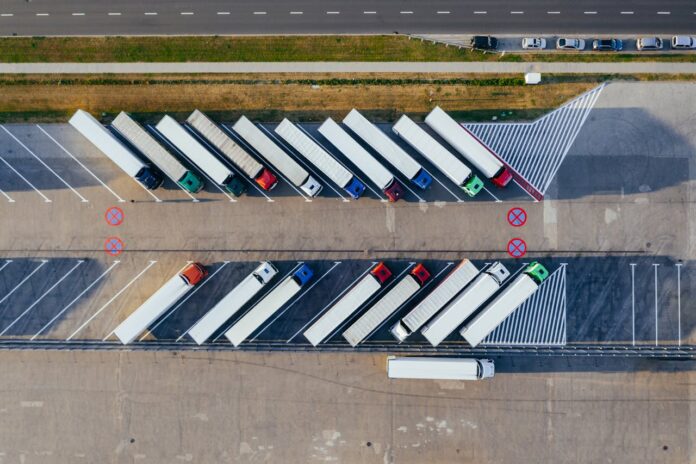
From small delivery trucks to enormous heavy-duty tractor-trailers, fleets are crucial to the U.S. economy. This sector hauls a massive 71% of all freight within the nation.
The downside, however, is that it consumes a lot of energy. In 2023, transportation was responsible for approximately 30% of all U.S. energy consumption. The majority of these emissions result from the combustion of gasoline and diesel in engines.
But with shifting energy demands and the imperative of sustainability, fleet operators are looking more and more to limit their greenhouse gas emissions. The objective? Cut emissions, save fuel, and get in front of regulations without compromising performance.
Luckily, a variety of sustainable solutions are available today. We’ll share a few of them here.
#1 Use Telematics to Drive Efficiency
Telematics acts as a fleet’s smart tracking system. It uses GPS technology and onboard diagnostics to monitor fleet operations.
One major benefit is precise fuel tracking. Modern telematics applications monitor fuel levels and usage instantly. This capability allows you to quickly identify vehicles that consistently exceed your fuel budget.
It tracks fuel spending by individual drivers and along specific routes. This information helps you pinpoint inefficiencies, which allows for targeted improvements and direct cost reductions.
Telematics also plays a vital role in improving driver habits. It monitors behaviors such as harsh braking, rapid acceleration, and speeding. Once you spot driving habits that aren’t the most efficient, you can offer coaching to help drivers learn fuel-saving and safer techniques.
Poorly maintained vehicles consume more fuel and produce higher emissions. This system provides proactive maintenance alerts, which prevent expensive breakdowns and keep vehicles running smoothly.
Fleets using telematics often see fuel cost reductions of 15% to 20%. It also helps reduce CO2 emissions by 10% to 25%. About 60% of U.S. fleets now use telematics. This number is expected to reach 90% by 2025.
#2 Switch to Alternative Fuels
Traditional fuels like gasoline and diesel are no longer the only choice for fleets. A wave of cleaner alternative fuels is emerging, offering opportunities to save money and contribute to a healthier environment.
Natural gas is a common alternative to traditional fuels. Over 175,000 natural gas vehicles operate in the U.S. It’s cleaner than both diesel and gasoline and produces fewer carbon dioxide emissions.
Propane is another clean-burning alternative fuel with a low carbon content. It produces fewer greenhouse gas emissions and can be 30% less costly than gasoline and 50% less than diesel.
There is hydrogen as well. It is, in fact, one of the cleanest burning fuels with high energy content. Challenges with storage infrastructure have long hindered its adoption.
Reticular materials such as metal-organic frameworks (MOFs) are offering a way forward. These nano-engineered materials can store hydrogen at low pressure and near ambient temperature, by adsorbing it onto their porous structure.
H2MOF notes that reticular material-based storage is a safer and more efficient alternative to traditional compression and liquefaction, able to efficiently store hydrogen while reducing the risks associated with high pressures or cryogenic temperatures.
What’s more, this solid-state hydrogen storage technology consumes less energy as it doesn’t require compression or liquefaction, hence leading to lower operational costs than conventional storage.
#3 Electrify Your Fleet
Commercial electric vehicle (EV) fleets are rapidly gaining popularity. They are replacing traditional fossil fuels with electricity. This shift includes delivery vans, trucks, and buses.
The benefits of EVs are substantial. They produce zero tailpipe emissions. This helps businesses meet sustainability goals and new EPA emissions standards. This improves air quality and boosts a company’s brand image.
Electric vehicles are also more energy-efficient than traditional gasoline or diesel vehicles. They offer instant torque for smoother acceleration.
As EVs have fewer moving parts, their maintenance bills are generally lower due to fewer moving parts in electric drivetrains. In fact, they can save around $300 per vehicle annually.
Sure, EVs may have higher upfront costs. But their lower operating and maintenance expenses mean that the total cost of ownership (TCO) over the vehicle’s lifespan can be more attractive than for traditional vehicles.
As more and more businesses adopt EVs, the U.S. is quickly expanding its EV charging network.
As of the end of 2024, there were over 204,000 public and publicly accessible workplace chargers. Public investments are planned to add 164,000 new DC fast chargers and 1.5 million new Level 2 chargers by 2030. EV battery costs have dropped by 90% in the last 15 years.
Charting the Path to a Sustainable, Profitable Future
Opting for sustainable fleet solutions is a great step forward. You are not just reducing your environmental footprint, but you are also building a more efficient, cost-effective, and resilient business.
Each of these sustainable solutions offers significant benefits on its own. But when combined, their impact on a fleet’s efficiency, cost savings, and environmental footprint is transformative.
You don’t have to overhaul everything at once, however. A smart approach involves starting small. Oh, and don’t forget that support and incentives are available to help with the transition. Before you know it, you’ll have a fleet that’s not just more sustainable, but also profitable.
Find a Home-Based Business to Start-Up >>> Hundreds of Business Listings.
















































